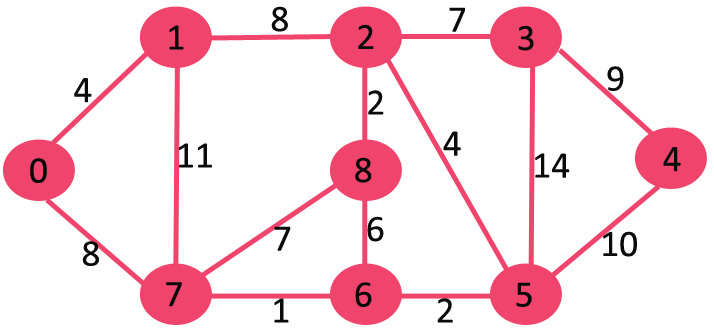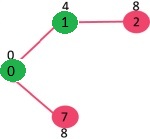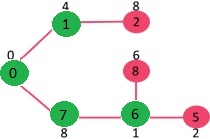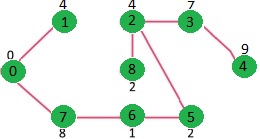我们建议阅读以下两篇文章,作为这篇文章的先决条件。
1.贪婪算法|设置5(Prim的最小生成树(MST))
2.图及其表示
我们已经讨论了图的邻接矩阵表示的Prim算法及其实现。矩阵表示的时间复杂度为O(V ^ 2)。在这篇文章中,讨论了用于邻接表表示的O(ELogV)算法。
如前一篇文章所述,在Prim的算法中,维护了两组,一组包含MST中已包含的顶点列表,另一组包含尚未包含的顶点。使用邻接表表示,可以使用BFS在O(V + E)时间内遍历图的所有顶点。这个想法是使用BFS遍历图的所有顶点,并使用Min Heap存储尚未包含在MST中的顶点。最小堆用作优先级队列,以从剪切中获得最小的权重边缘。 Min Heap用作提取最小元素和减小键值的操作的时间复杂性(在Min Heap中为O(LogV))。
以下是详细步骤。
1)创建大小为V的最小堆,其中V是给定图中的顶点数。最小堆的每个节点都包含顶点号和顶点的键值。
2)以第一个顶点为根初始化Min Heap(分配给第一个顶点的键值为0)。分配给所有其他顶点的键值为INF(无穷大)。
3)当Min Heap不为空时,请执行以下操作
….. a)从Min Heap中提取min值节点。令提取的顶点为u。
….. b)对于u的每个相邻顶点v,检查v是否在Min Heap中(尚未包含在MST中)。如果v在“最小堆”中,并且其键值大于uv的权重,则将v的键值更新为uv的权重。
让我们通过以下示例了解上述算法: 
最初,对于所有其他顶点,第一个顶点的关键值为0,INF为无穷大。因此,从最小堆中提取顶点0,并更新与0(1和7)相邻的顶点的键值。最小堆包含除顶点0以外的所有顶点。
绿色的顶点是MST中包含的顶点。 
由于顶点1的键值在Min Heap中的所有节点中最小,因此将从Min Heap中提取顶点,并更新与1相邻的顶点的键值(如果顶点在Min Heap中且先前键值大于从1到相邻边的权重)。最小堆包含除顶点0和1以外的所有顶点。 
由于顶点7的关键值在“最小堆”中的所有节点中最小,因此将从“最小堆”中提取顶点,并更新与7相邻的顶点的关键值(如果顶点在“最小堆”中且先前的关键值大于从7到相邻边缘的权重)。最小堆包含除顶点0、1和7以外的所有顶点。 
由于顶点6的关键值在“最小堆”中的所有节点中最小,因此将从“最小堆”中提取顶点,并更新与6相邻的顶点的关键值(如果顶点在“最小堆”中且先前的关键值大于从6到相邻边的权重)。最小堆包含除顶点0、1、7和6以外的所有顶点。 
对“最小堆”中的其余节点重复上述步骤,直到“最小堆”变空
C++
// C / C++ program for Prim's MST for adjacency list representation of graph
#include
#include
#include
// A structure to represent a node in adjacency list
struct AdjListNode {
int dest;
int weight;
struct AdjListNode* next;
};
// A structure to represent an adjacency list
struct AdjList {
struct AdjListNode* head; // pointer to head node of list
};
// A structure to represent a graph. A graph is an array of adjacency lists.
// Size of array will be V (number of vertices in graph)
struct Graph {
int V;
struct AdjList* array;
};
// A utility function to create a new adjacency list node
struct AdjListNode* newAdjListNode(int dest, int weight)
{
struct AdjListNode* newNode = (struct AdjListNode*)malloc(sizeof(struct AdjListNode));
newNode->dest = dest;
newNode->weight = weight;
newNode->next = NULL;
return newNode;
}
// A utility function that creates a graph of V vertices
struct Graph* createGraph(int V)
{
struct Graph* graph = (struct Graph*)malloc(sizeof(struct Graph));
graph->V = V;
// Create an array of adjacency lists. Size of array will be V
graph->array = (struct AdjList*)malloc(V * sizeof(struct AdjList));
// Initialize each adjacency list as empty by making head as NULL
for (int i = 0; i < V; ++i)
graph->array[i].head = NULL;
return graph;
}
// Adds an edge to an undirected graph
void addEdge(struct Graph* graph, int src, int dest, int weight)
{
// Add an edge from src to dest. A new node is added to the adjacency
// list of src. The node is added at the beginning
struct AdjListNode* newNode = newAdjListNode(dest, weight);
newNode->next = graph->array[src].head;
graph->array[src].head = newNode;
// Since graph is undirected, add an edge from dest to src also
newNode = newAdjListNode(src, weight);
newNode->next = graph->array[dest].head;
graph->array[dest].head = newNode;
}
// Structure to represent a min heap node
struct MinHeapNode {
int v;
int key;
};
// Structure to represent a min heap
struct MinHeap {
int size; // Number of heap nodes present currently
int capacity; // Capacity of min heap
int* pos; // This is needed for decreaseKey()
struct MinHeapNode** array;
};
// A utility function to create a new Min Heap Node
struct MinHeapNode* newMinHeapNode(int v, int key)
{
struct MinHeapNode* minHeapNode = (struct MinHeapNode*)malloc(sizeof(struct MinHeapNode));
minHeapNode->v = v;
minHeapNode->key = key;
return minHeapNode;
}
// A utilit function to create a Min Heap
struct MinHeap* createMinHeap(int capacity)
{
struct MinHeap* minHeap = (struct MinHeap*)malloc(sizeof(struct MinHeap));
minHeap->pos = (int*)malloc(capacity * sizeof(int));
minHeap->size = 0;
minHeap->capacity = capacity;
minHeap->array = (struct MinHeapNode**)malloc(capacity * sizeof(struct MinHeapNode*));
return minHeap;
}
// A utility function to swap two nodes of min heap. Needed for min heapify
void swapMinHeapNode(struct MinHeapNode** a, struct MinHeapNode** b)
{
struct MinHeapNode* t = *a;
*a = *b;
*b = t;
}
// A standard function to heapify at given idx
// This function also updates position of nodes when they are swapped.
// Position is needed for decreaseKey()
void minHeapify(struct MinHeap* minHeap, int idx)
{
int smallest, left, right;
smallest = idx;
left = 2 * idx + 1;
right = 2 * idx + 2;
if (left < minHeap->size && minHeap->array[left]->key < minHeap->array[smallest]->key)
smallest = left;
if (right < minHeap->size && minHeap->array[right]->key < minHeap->array[smallest]->key)
smallest = right;
if (smallest != idx) {
// The nodes to be swapped in min heap
MinHeapNode* smallestNode = minHeap->array[smallest];
MinHeapNode* idxNode = minHeap->array[idx];
// Swap positions
minHeap->pos[smallestNode->v] = idx;
minHeap->pos[idxNode->v] = smallest;
// Swap nodes
swapMinHeapNode(&minHeap->array[smallest], &minHeap->array[idx]);
minHeapify(minHeap, smallest);
}
}
// A utility function to check if the given minHeap is ampty or not
int isEmpty(struct MinHeap* minHeap)
{
return minHeap->size == 0;
}
// Standard function to extract minimum node from heap
struct MinHeapNode* extractMin(struct MinHeap* minHeap)
{
if (isEmpty(minHeap))
return NULL;
// Store the root node
struct MinHeapNode* root = minHeap->array[0];
// Replace root node with last node
struct MinHeapNode* lastNode = minHeap->array[minHeap->size - 1];
minHeap->array[0] = lastNode;
// Update position of last node
minHeap->pos[root->v] = minHeap->size - 1;
minHeap->pos[lastNode->v] = 0;
// Reduce heap size and heapify root
--minHeap->size;
minHeapify(minHeap, 0);
return root;
}
// Function to decrease key value of a given vertex v. This function
// uses pos[] of min heap to get the current index of node in min heap
void decreaseKey(struct MinHeap* minHeap, int v, int key)
{
// Get the index of v in heap array
int i = minHeap->pos[v];
// Get the node and update its key value
minHeap->array[i]->key = key;
// Travel up while the complete tree is not hepified.
// This is a O(Logn) loop
while (i && minHeap->array[i]->key < minHeap->array[(i - 1) / 2]->key) {
// Swap this node with its parent
minHeap->pos[minHeap->array[i]->v] = (i - 1) / 2;
minHeap->pos[minHeap->array[(i - 1) / 2]->v] = i;
swapMinHeapNode(&minHeap->array[i], &minHeap->array[(i - 1) / 2]);
// move to parent index
i = (i - 1) / 2;
}
}
// A utility function to check if a given vertex
// 'v' is in min heap or not
bool isInMinHeap(struct MinHeap* minHeap, int v)
{
if (minHeap->pos[v] < minHeap->size)
return true;
return false;
}
// A utility function used to print the constructed MST
void printArr(int arr[], int n)
{
for (int i = 1; i < n; ++i)
printf("%d - %d\n", arr[i], i);
}
// The main function that constructs Minimum Spanning Tree (MST)
// using Prim's algorithm
void PrimMST(struct Graph* graph)
{
int V = graph->V; // Get the number of vertices in graph
int parent[V]; // Array to store constructed MST
int key[V]; // Key values used to pick minimum weight edge in cut
// minHeap represents set E
struct MinHeap* minHeap = createMinHeap(V);
// Initialize min heap with all vertices. Key value of
// all vertices (except 0th vertex) is initially infinite
for (int v = 1; v < V; ++v) {
parent[v] = -1;
key[v] = INT_MAX;
minHeap->array[v] = newMinHeapNode(v, key[v]);
minHeap->pos[v] = v;
}
// Make key value of 0th vertex as 0 so that it
// is extracted first
key[0] = 0;
minHeap->array[0] = newMinHeapNode(0, key[0]);
minHeap->pos[0] = 0;
// Initially size of min heap is equal to V
minHeap->size = V;
// In the following loop, min heap contains all nodes
// not yet added to MST.
while (!isEmpty(minHeap)) {
// Extract the vertex with minimum key value
struct MinHeapNode* minHeapNode = extractMin(minHeap);
int u = minHeapNode->v; // Store the extracted vertex number
// Traverse through all adjacent vertices of u (the extracted
// vertex) and update their key values
struct AdjListNode* pCrawl = graph->array[u].head;
while (pCrawl != NULL) {
int v = pCrawl->dest;
// If v is not yet included in MST and weight of u-v is
// less than key value of v, then update key value and
// parent of v
if (isInMinHeap(minHeap, v) && pCrawl->weight < key[v]) {
key[v] = pCrawl->weight;
parent[v] = u;
decreaseKey(minHeap, v, key[v]);
}
pCrawl = pCrawl->next;
}
}
// print edges of MST
printArr(parent, V);
}
// Driver program to test above functions
int main()
{
// Let us create the graph given in above fugure
int V = 9;
struct Graph* graph = createGraph(V);
addEdge(graph, 0, 1, 4);
addEdge(graph, 0, 7, 8);
addEdge(graph, 1, 2, 8);
addEdge(graph, 1, 7, 11);
addEdge(graph, 2, 3, 7);
addEdge(graph, 2, 8, 2);
addEdge(graph, 2, 5, 4);
addEdge(graph, 3, 4, 9);
addEdge(graph, 3, 5, 14);
addEdge(graph, 4, 5, 10);
addEdge(graph, 5, 6, 2);
addEdge(graph, 6, 7, 1);
addEdge(graph, 6, 8, 6);
addEdge(graph, 7, 8, 7);
PrimMST(graph);
return 0;
} Java
// Java program for Prim's MST for
// adjacency list representation of graph
import java.util.LinkedList;
import java.util.TreeSet;
import java.util.Comparator;
public class prims {
class node1 {
// Stores destination vertex in adjacency list
int dest;
// Stores weight of a vertex in the adjacency list
int weight;
// Constructor
node1(int a, int b)
{
dest = a;
weight = b;
}
}
static class Graph {
// Number of vertices in the graph
int V;
// List of adjacent nodes of a given vertex
LinkedList[] adj;
// Constructor
Graph(int e)
{
V = e;
adj = new LinkedList[V];
for (int o = 0; o < V; o++)
adj[o] = new LinkedList<>();
}
}
// class to represent a node in PriorityQueue
// Stores a vertex and its corresponding
// key value
class node {
int vertex;
int key;
}
// Comparator class created for PriorityQueue
// returns 1 if node0.key > node1.key
// returns 0 if node0.key < node1.key and
// returns -1 otherwise
class comparator implements Comparator {
@Override
public int compare(node node0, node node1)
{
return node0.key - node1.key;
}
}
// method to add an edge
// between two vertices
void addEdge(Graph graph, int src, int dest, int weight)
{
node1 node0 = new node1(dest, weight);
node1 node = new node1(src, weight);
graph.adj[src].addLast(node0);
graph.adj[dest].addLast(node);
}
// method used to find the mst
void prims_mst(Graph graph)
{
// Whether a vertex is in PriorityQueue or not
Boolean[] mstset = new Boolean[graph.V];
node[] e = new node[graph.V];
// Stores the parents of a vertex
int[] parent = new int[graph.V];
for (int o = 0; o < graph.V; o++)
e[o] = new node();
for (int o = 0; o < graph.V; o++) {
// Initialize to false
mstset[o] = false;
// Initialize key values to infinity
e[o].key = Integer.MAX_VALUE;
e[o].vertex = o;
parent[o] = -1;
}
// Include the source vertex in mstset
mstset[0] = true;
// Set key value to 0
// so that it is extracted first
// out of PriorityQueue
e[0].key = 0;
// Use TreeSet instead of PriorityQueue as the remove function of the PQ is O(n) in java.
TreeSet queue = new TreeSet(new comparator());
for (int o = 0; o < graph.V; o++)
queue.add(e[o]);
// Loops until the queue is not empty
while (!queue.isEmpty()) {
// Extracts a node with min key value
node node0 = queue.pollFirst();
// Include that node into mstset
mstset[node0.vertex] = true;
// For all adjacent vertex of the extracted vertex V
for (node1 iterator : graph.adj[node0.vertex]) {
// If V is in queue
if (mstset[iterator.dest] == false) {
// If the key value of the adjacent vertex is
// more than the extracted key
// update the key value of adjacent vertex
// to update first remove and add the updated vertex
if (e[iterator.dest].key > iterator.weight) {
queue.remove(e[iterator.dest]);
e[iterator.dest].key = iterator.weight;
queue.add(e[iterator.dest]);
parent[iterator.dest] = node0.vertex;
}
}
}
}
// Prints the vertex pair of mst
for (int o = 1; o < graph.V; o++)
System.out.println(parent[o] + " "
+ "-"
+ " " + o);
}
public static void main(String[] args)
{
int V = 9;
Graph graph = new Graph(V);
prims e = new prims();
e.addEdge(graph, 0, 1, 4);
e.addEdge(graph, 0, 7, 8);
e.addEdge(graph, 1, 2, 8);
e.addEdge(graph, 1, 7, 11);
e.addEdge(graph, 2, 3, 7);
e.addEdge(graph, 2, 8, 2);
e.addEdge(graph, 2, 5, 4);
e.addEdge(graph, 3, 4, 9);
e.addEdge(graph, 3, 5, 14);
e.addEdge(graph, 4, 5, 10);
e.addEdge(graph, 5, 6, 2);
e.addEdge(graph, 6, 7, 1);
e.addEdge(graph, 6, 8, 6);
e.addEdge(graph, 7, 8, 7);
// Method invoked
e.prims_mst(graph);
}
}
// This code is contributed by Vikash Kumar Dubey Python
# A Python program for Prims's MST for
# adjacency list representation of graph
from collections import defaultdict
import sys
class Heap():
def __init__(self):
self.array = []
self.size = 0
self.pos = []
def newMinHeapNode(self, v, dist):
minHeapNode = [v, dist]
return minHeapNode
# A utility function to swap two nodes of
# min heap. Needed for min heapify
def swapMinHeapNode(self, a, b):
t = self.array[a]
self.array[a] = self.array[b]
self.array[b] = t
# A standard function to heapify at given idx
# This function also updates position of nodes
# when they are swapped. Position is needed
# for decreaseKey()
def minHeapify(self, idx):
smallest = idx
left = 2 * idx + 1
right = 2 * idx + 2
if left < self.size and self.array[left][1] < \
self.array[smallest][1]:
smallest = left
if right < self.size and self.array[right][1] < \
self.array[smallest][1]:
smallest = right
# The nodes to be swapped in min heap
# if idx is not smallest
if smallest != idx:
# Swap positions
self.pos[ self.array[smallest][0] ] = idx
self.pos[ self.array[idx][0] ] = smallest
# Swap nodes
self.swapMinHeapNode(smallest, idx)
self.minHeapify(smallest)
# Standard function to extract minimum node from heap
def extractMin(self):
# Return NULL wif heap is empty
if self.isEmpty() == True:
return
# Store the root node
root = self.array[0]
# Replace root node with last node
lastNode = self.array[self.size - 1]
self.array[0] = lastNode
# Update position of last node
self.pos[lastNode[0]] = 0
self.pos[root[0]] = self.size - 1
# Reduce heap size and heapify root
self.size -= 1
self.minHeapify(0)
return root
def isEmpty(self):
return True if self.size == 0 else False
def decreaseKey(self, v, dist):
# Get the index of v in heap array
i = self.pos[v]
# Get the node and update its dist value
self.array[i][1] = dist
# Travel up while the complete tree is not
# hepified. This is a O(Logn) loop
while i > 0 and self.array[i][1] < \
self.array[(i - 1) / 2][1]:
# Swap this node with its parent
self.pos[ self.array[i][0] ] = (i-1)/2
self.pos[ self.array[(i-1)/2][0] ] = i
self.swapMinHeapNode(i, (i - 1)/2 )
# move to parent index
i = (i - 1) / 2;
# A utility function to check if a given vertex
# 'v' is in min heap or not
def isInMinHeap(self, v):
if self.pos[v] < self.size:
return True
return False
def printArr(parent, n):
for i in range(1, n):
print "% d - % d" % (parent[i], i)
class Graph():
def __init__(self, V):
self.V = V
self.graph = defaultdict(list)
# Adds an edge to an undirected graph
def addEdge(self, src, dest, weight):
# Add an edge from src to dest. A new node is
# added to the adjacency list of src. The node
# is added at the beginning. The first element of
# the node has the destination and the second
# elements has the weight
newNode = [dest, weight]
self.graph[src].insert(0, newNode)
# Since graph is undirected, add an edge from
# dest to src also
newNode = [src, weight]
self.graph[dest].insert(0, newNode)
# The main function that prints the Minimum
# Spanning Tree(MST) using the Prim's Algorithm.
# It is a O(ELogV) function
def PrimMST(self):
# Get the number of vertices in graph
V = self.V
# key values used to pick minimum weight edge in cut
key = []
# List to store contructed MST
parent = []
# minHeap represents set E
minHeap = Heap()
# Initialize min heap with all vertices. Key values of all
# vertices (except the 0th vertex) is is initially infinite
for v in range(V):
parent.append(-1)
key.append(sys.maxint)
minHeap.array.append( minHeap.newMinHeapNode(v, key[v]) )
minHeap.pos.append(v)
# Make key value of 0th vertex as 0 so
# that it is extracted first
minHeap.pos[0] = 0
key[0] = 0
minHeap.decreaseKey(0, key[0])
# Initially size of min heap is equal to V
minHeap.size = V;
# In the following loop, min heap contains all nodes
# not yet added in the MST.
while minHeap.isEmpty() == False:
# Extract the vertex with minimum distance value
newHeapNode = minHeap.extractMin()
u = newHeapNode[0]
# Traverse through all adjacent vertices of u
# (the extracted vertex) and update their
# distance values
for pCrawl in self.graph[u]:
v = pCrawl[0]
# If shortest distance to v is not finalized
# yet, and distance to v through u is less than
# its previously calculated distance
if minHeap.isInMinHeap(v) and pCrawl[1] < key[v]:
key[v] = pCrawl[1]
parent[v] = u
# update distance value in min heap also
minHeap.decreaseKey(v, key[v])
printArr(parent, V)
# Driver program to test the above functions
graph = Graph(9)
graph.addEdge(0, 1, 4)
graph.addEdge(0, 7, 8)
graph.addEdge(1, 2, 8)
graph.addEdge(1, 7, 11)
graph.addEdge(2, 3, 7)
graph.addEdge(2, 8, 2)
graph.addEdge(2, 5, 4)
graph.addEdge(3, 4, 9)
graph.addEdge(3, 5, 14)
graph.addEdge(4, 5, 10)
graph.addEdge(5, 6, 2)
graph.addEdge(6, 7, 1)
graph.addEdge(6, 8, 6)
graph.addEdge(7, 8, 7)
graph.PrimMST()
# This code is contributed by Divyanshu Mehta输出:
0 - 1
5 - 2
2 - 3
3 - 4
6 - 5
7 - 6
0 - 7
2 - 8时间复杂度:上面的代码/算法的时间复杂度看起来是O(V ^ 2),因为有两个嵌套的while循环。如果仔细观察,可以观察到内部循环中的语句执行了O(V + E)次(类似于BFS)。内部循环具有reduceKey()操作,该操作需要O(LogV)时间。因此,总体时间复杂度为O(E + V)* O(LogV),即O((E + V)* LogV)= O(ELogV)(对于连通图,V = O(E))
参考:
Clifford Stein,Thomas H.Cormen,Charles E.Leiserson,Ronald L. http://en.wikipedia.org/wiki/Prim’s_algorithm